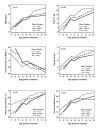Short sleep duration and adiposity in Chinese adolescents
- PMID: 18246978
- PMCID: PMC2276131
- DOI: 10.1093/sleep/30.12.1688
Short sleep duration and adiposity in Chinese adolescents
Abstract
Objective: To investigate the relationship between sleep duration and adiposity measurements in rural Chinese adolescents.
Methods: This report is based on a cross-sectional analysis of 500 Chinese adolescent twins. Anthropometric measurements and direct adiposity measurements using dual-energy X-ray absorptiometry (DEXA) were taken for all subjects. Standard sleep questionnaires and a 7-day diary were administered to assess sleep duration.
Results: Sleep duration decreased with increasing age during adolescence, reaching a nadir at approximately 15 years of age. While BMI and body fat increased through the entire range of adolescence for both genders, after the age of 12, females had much higher amounts of total and truncal fat than males. Graphic plots showed that among females, both long and short sleepers tended to have higher adiposity measures than medium duration sleepers. The association of short sleep duration with higher adiposity measures was significant even after adjustment for covariates. This association was stronger for total and truncal fat and waist circumference (P < 0.05) than for BMI (P = 0.06). In contrast, consistent relationships between sleep duration and adiposity measures were not seen in males.
Conclusion: Even in this relatively lean Chinese adolescent cohort, short sleep duration was significantly associated with higher adiposity measures and lower lean body mass in females. The results of this study indicate that the observed association between short sleep duration and higher BMI is most likely mediated by factors associated with total and central adiposity rather than lean body mass.
Figures
Similar articles
-
Short sleep duration is associated with insulin resistance independent of adiposity in Chinese adult twins.Sleep Med. 2011 Oct;12(9):914-9. doi: 10.1016/j.sleep.2011.04.006. Epub 2011 Sep 21. Sleep Med. 2011. PMID: 21940204 Free PMC article.
-
A population-based twin study on sleep duration and body composition.Obesity (Silver Spring). 2012 Jan;20(1):192-9. doi: 10.1038/oby.2011.274. Epub 2011 Aug 25. Obesity (Silver Spring). 2012. PMID: 21869757
-
Adiposity in Adolescents: The Interplay of Sleep Duration and Sleep Variability.J Pediatr. 2018 Dec;203:309-316. doi: 10.1016/j.jpeds.2018.07.087. Epub 2018 Sep 20. J Pediatr. 2018. PMID: 30243536 Free PMC article.
-
Patterns and interrelationships of body-fat measures among rural Chinese children aged 6 to 18 years.Pediatrics. 2007 Jul;120(1):e94-e101. doi: 10.1542/peds.2006-2114. Pediatrics. 2007. PMID: 17606554
-
Visceral adiposity and inflammatory bowel disease.Int J Colorectal Dis. 2021 Nov;36(11):2305-2319. doi: 10.1007/s00384-021-03968-w. Epub 2021 Jun 9. Int J Colorectal Dis. 2021. PMID: 34104989 Review.
Cited by
-
Differences in lifestyle behaviors, dietary habits, and familial factors among normal-weight, overweight, and obese Chinese children and adolescents.Int J Behav Nutr Phys Act. 2012 Oct 2;9:120. doi: 10.1186/1479-5868-9-120. Int J Behav Nutr Phys Act. 2012. PMID: 23031205 Free PMC article.
-
Sleep patterns are associated with common illness in adolescents.J Sleep Res. 2014 Apr;23(2):133-42. doi: 10.1111/jsr.12096. Epub 2013 Oct 18. J Sleep Res. 2014. PMID: 24134661 Free PMC article.
-
Longitudinal analysis of sleep in relation to BMI and body fat in children: the FLAME study.BMJ. 2011 May 26;342:d2712. doi: 10.1136/bmj.d2712. BMJ. 2011. PMID: 21622518 Free PMC article.
-
Gender Differences in the Association between Sleep Duration and Body Composition: The Cardia Study.Int J Endocrinol. 2010;2010:726071. doi: 10.1155/2010/726071. Epub 2009 Nov 12. Int J Endocrinol. 2010. PMID: 20049158 Free PMC article.
-
Children's sleep needs: is there sufficient evidence to recommend optimal sleep for children?Sleep. 2013 Apr 1;36(4):527-34. doi: 10.5665/sleep.2538. Sleep. 2013. PMID: 23564999 Free PMC article. Review.
References
-
- Mokdad AH, Ford ES, Bowman BA, et al. Prevalence of obesity, diabetes, and obesity-related health risk factors, 2001. JAMA. 2003;289:76–9. - PubMed
-
- Gangwisch JE, Malaspina D, Boden-Albala B, Heymsfield SB. Inadequate sleep as a risk factor for obesity: analyses of the NHANES I. Sleep. 2005;28:1289–96. - PubMed
-
- Vorona RD, Winn MP, Babineau TW, Eng BP, Feldman HR, Ware JC. Overweight and obese patients in a primary care population report less sleep than patients with a normal body mass index. Arch Intern Med. 2005;165:25–30. - PubMed
-
- Kripke DF, Simons RN, Garfinkel L, Hammond EC. Short and long sleep and sleeping pills. Is increased mortality associated? Arch Gen Psychiatry. 1979;36:103–16. - PubMed
-
- National Sleep Foundation. 2005 “Sleep in America” Poll. Washington DC: National Sleep Foundation; 2005.
Publication types
MeSH terms
Grants and funding
LinkOut - more resources
Full Text Sources
Medical




